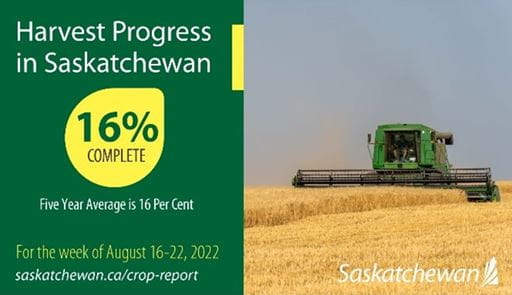Released on August 25, 2022
Hot, dry weather allowed for tremendous harvest progress, especially in the southwest and west-central regions. Some areas in the east-central region received heavy rainfall once again, which has slowed down the maturation of crops or halted producers who are ready to begin harvest of early seeded crops. Harvest progress sits at 16 per cent, up from five per cent last week and right on par with the five-year average. An additional 12 per cent of the crop is now swathed or ready to straight-cut.
Harvest progress is most advanced in the southwest region where farmers have 45 per cent of their crop now in the bin, followed by producers in the west-central who have 19 per cent of their crop harvested. Farmers in the southeast have six per cent of crop off their fields, the east-central has completed four percent and both the northern regions have one per cent of their crop harvested. For many producers in the wetter areas of the province, harvest will not begin for another week or more as their crops have not matured yet.
63 per cent of the winter wheat, 36 per cent of the fall rye, 52 per cent of the lentils, 43 per cent of the field peas, 30 per cent of the durum, six per cent of the spring wheat and three per cent of the canola has been combined.

Several localized rain showers passed through the province over the past week, mainly over the eastern and northern regions with some parts of the southern regions receiving precipitation ranging from nil to 18 mm in the Moosomin area. The Yorkton area received 36 mm, the Eyebrow area 28 mm, the Foam Lake area 26 mm, the Hudson Bay area 22 mm and the Hafford area eight mm. Grain producers across the province would like to see a halt in the rain so they can either maintain momentum with harvest operations or to allow their crops to finally ripen so that harvest may begin. Many producers have voiced concern over how badly they will need rain once harvest is completed to recharge the soil moisture of their respective regions.
Cropland topsoil moisture is rated as one per cent surplus, 56 per cent adequate, 26 per cent short and 17 per cent very short. Hay and pastureland topsoil moisture is rated as three per cent surplus, 52 per cent adequate, 29 per cent short and 16 per cent very short.
Provincially, pasture conditions are rated as six per cent excellent, 37 per cent good, 28 per cent fair, 16 per cent poor and 13 per cent very poor. Pastures have greatly improved this year due to more frequent rains; the largest improvement has been seen in the eastern half of the province along with the northwest region. In the southwest and west-central regions, pastures have not fared as well due to suffering through extremely dry growing conditions once again.
The majority of crop damage this week was due to wind, heavy rainfall and hail. Grasshoppers continue to cause large amounts of crop loss, with producers already worried about what their population next year will be and how they will manage to control them. There were also a handful of reports of sawfly damage in some wheat fields this past week, but producers are saying that damage is low for the time being.
Farmers are busy getting equipment and bins ready for harvest and waiting for their crop to dry enough to allow combining. With harvest underway in Saskatchewan, we want to remind producers to exercise caution and remain safe. Give equipment plenty of time and space when traveling down or crossing highways or other roads. Producers are reminded to have firefighting equipment nearby especially in regions that are extremely dry.
A complete, printable version of the Crop Report is available at Crop Report.
Follow the 2022 Crop Report on Twitter at @SKAgriculture.
-30-
For more information, contact:
Matthew Struthers
Agriculture
Phone: 306-694-3714
Email: matt.struthers@gov.sk.ca

